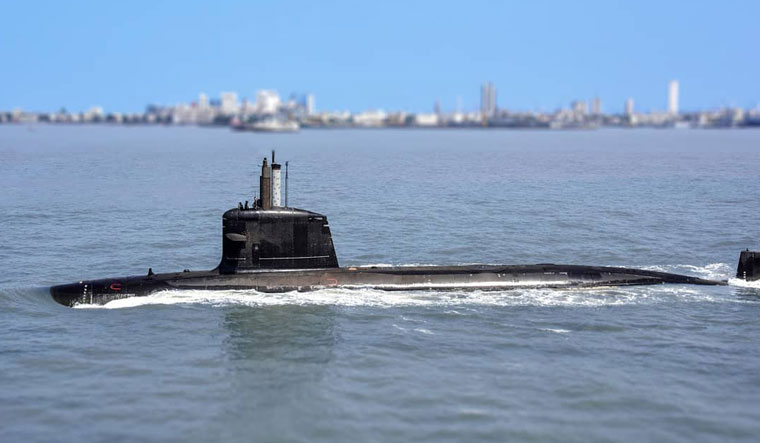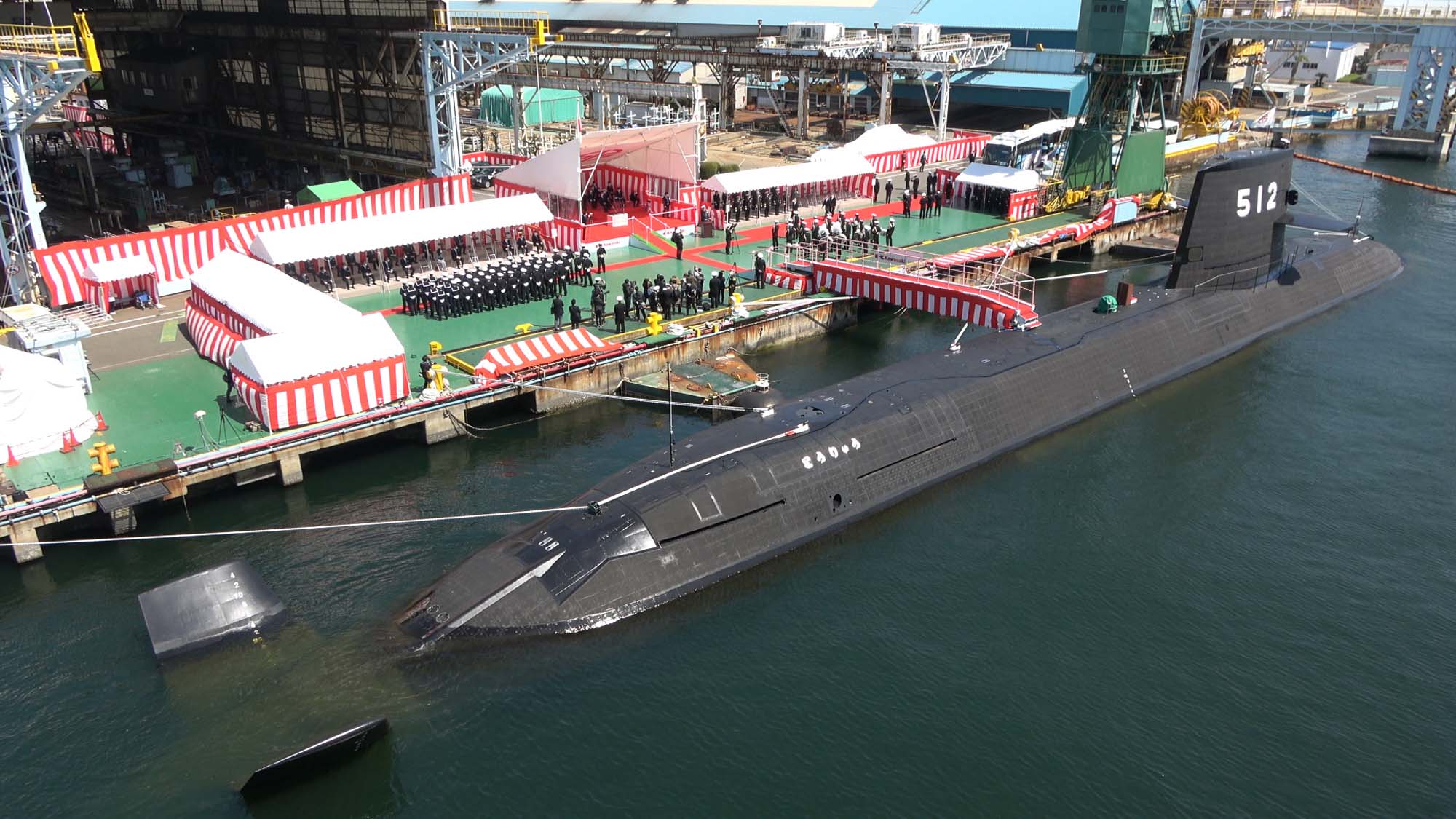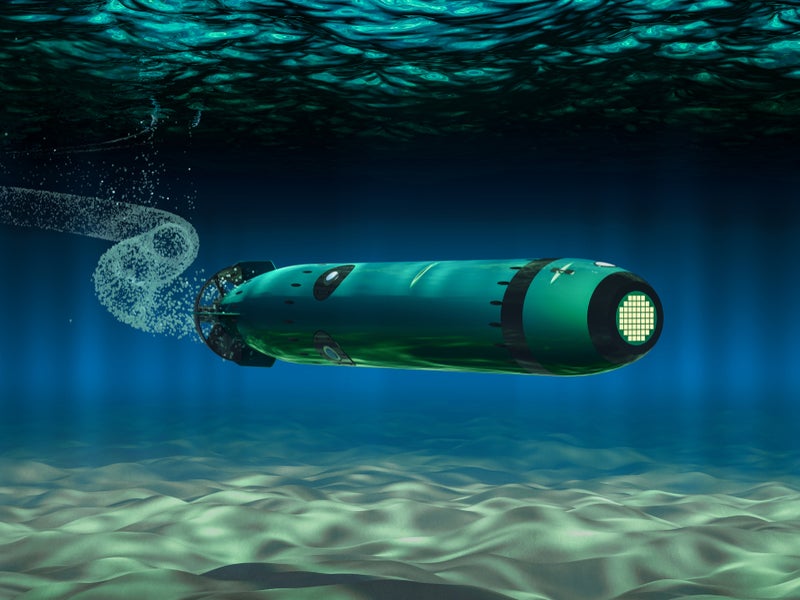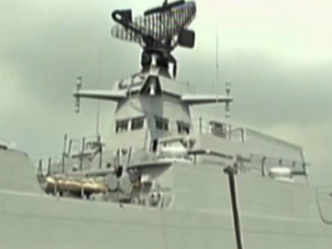KSS-III submarine
The
KSS-III submarine, also classified as the
Dosan Ahn Changho-class submarines - is a series of
diesel-electric attack submarines currently being built for the
Republic of Korea Navy (ROKN), jointly by
Daewoo Shipbuilding & Marine Engineering (DSME) and
Hyundai Heavy Industries (HHI).
[4] The KSS-III is the final phase of the
Korean Attack Submarine program, a three-phased program to build 27 attack submarines for the ROKN, between 1994–2029.
[22]
The KSS-III initiative consists of the development of nine diesel-electric attack submarines, capable of firing
submarine-launched ballistic missiles (SLBM), to be built in three batches, between 2014–2029.
[4][23]
A total of three submarines of the first batch of the series have been
launched, with the first submarine,
ROKS Dosan Ahn Changho, being
commissioned on 13 August 2019.
[2]
Design[edit]
Background[edit]
The design of the KSS-III was jointly designed by
Daewoo Shipbuilding & Marine Engineering (DSME) and
Hyundai Heavy Industries (HHI) - two of
South Korea's largest shipbuilding enterprises; preparations for the design began in 2007.
[24][25] The KSS-III are the largest submarines to ever be built by South Korea and are reportedly based on the design of the German-origin
Type 214 submarine - developed by
ThyssenKrupp Marine Systems (TKMS) and license-built by both DSME and HHI, between 2002-2020.
[26][27]
Batch-I[edit]
The Batch-I series is the first phase of the KSS-III program - consisting of the construction of three
attack submarines - with the first two to be built by DSME and the third one to be built by HHI.
[28]
The Batch-I design possesses a length of 83.5 metres (273 ft 11 in), with a breadth of 9.6 m (31 ft 6 in) and a
draught of 7.62 m (25 ft 0 in) - with a
displacement of 3,358
tonnes (3,305
long tons) while surfaced and 3,750 tonnes (3,690 long tons) while submerged; they are the first submarines with a displacement of 3,000 tonnes to ever be built by South Korea.
[29][16][30][31] According to DSME, over 76% of the submarine's components were procured from within South Korea.
[31]
The Batch-I design has an estimated speed of about 12
knots (22 km/h; 14 mph) while surfaced, and 20 knots (37 km/h; 23 mph) while submerged - and possesses a cruising range of around 10,000
nautical miles (19,000 km; 12,000 mi), at economic speed, along with a crew complement of 50.
[32] The design further incorporates an indigenously-designed
fuel-cell powered air-independent propulsion (AIP) module - which enables the submarine to conduct long-distance underwater operations for up to 20 days.
[33]
The design accommodates six
Korean Vertical Launching System (K-VLS) cells, located behind the submarine's
sail - for carrying six
Hyunmoo 4-4 submarine-launched ballistic missiles (SLBM), along with six 533-millimetre (21 in) forward-firing
torpedo tubes, located at the
bow.
[34] Coincidentally, the KSS-III is the first ever AIP-equipped attack-submarine, capable of launching submarine-launched ballistic missiles.
[19]
Batch-II[edit]
The Batch-II series constitutes the second phase of the KSS-III program - and is noted to possess multiple improvements in terms of design, armament and automation, over the Batch-I series.
[35]
The Batch-II design possesses a length of 89 m (292 ft), with a breadth of 9.6 m (31 ft), along with an estimated displacement of around 3,600 t (3,500 long tons).
[36][37] According to DSME, the Batch-II series will be equipped with "a greater level of South Korean technology" - with over 80% of the submarine's parts to be domestically sourced.
[38][39]
Similar to the Batch-I, the Batch-II will also reportedly have a top speed of 20 knots (37 km/h; 23 mph) and a crew complement of 50.
[36]
A notable feature of the Batch-II submarines is its
lithium-ion battery technology (LiB); the Batch-II series will be equipped with lithium-ion batteries - developed by
Samsung SDI (and supplied by
Hanwha Defense), apart from the AIP system.
[40] Compared to previous
lead-acid batteries which are generally used to power other conventionally-powered submarines, the new lithium-ion batteries will reportedly allow the KSS-III to cruise at greater speeds with a greater period of underwater endurance, life-expectancy and durability.
[41] Incidentally, Korea is only the second country in the world to field submarines equipped with lithium-ion batteries; the first is Japan - which utilizes lithium-ion battery technology aboard its
Sōryū-class submarines.
[42]
The design also incorporates ten (K-VLS) cells (compared to six on the Batch-I) - which are presumably to carry the Hyunmoo 4-4 ballistic missiles and the future
Chonryong land-attack cruise missile.
[43]
Instrumentation[edit]
Armament[edit]
- Torpedoes – The KSS-III is equipped with six 533 mm (21 in) forward-firing torpedo tubes, for firing the "Tiger Shark" heavyweight torpedoes, developed by LIG Nex1.[44][45]
- Missiles – The Batch-I submarines are equipped with six K-VLS cells, capable of launching the Hyunmoo 4-4 ballistic missiles - which is estimated to possess a range of around 500 km (310 mi).[40][46] In stark contrast, the Batch-II submarines will be equipped to ten K-VLS cells - presumably for carrying the Hyunmoo 4-4 - as well as the future Chonryong land-attack cruise missile, currently in development.[43][47]
- Weapon Handling System – The Batch-I vessels are also equipped with a "Weapons Handling and Launch System" (WHLS) - developed by UK-based naval conglomerate Babcock International.[16]
Sensors[edit]
The Batch-I series is currently equipped with an assortment of different sensors and equipment, including:
- Combat Management Suite – A "Naval Shield Integrated Combat Management System" (ICMS), developed by Hanhwa.[48]
- Sonar – A sonar suite, developed by LIG Nex1, comprising:-[49]
- Flank-array sonar (FAS)
- Towed-array sonar
- Intercept-passive sonar
- Continuous-active sonar (CAS)
- Mine-avoidance sonar, developed by Thales[15]
- Electronic warfare – "Pegaso" radar electronic support-measures (RESM), developed by Indra.[50]
- Other systems
Construction[edit]
Batch-I[edit]
On 26 December 2012 - South Korea's
Ministry of National Defense (MND) contracted DSME to build the first two Batch-I submarines - at an estimated cost of
USD $1.56 billion.
[16] On 30 November 2016 - the MND contracted HHI to build the third submarine of the series.
[28]
The construction of the first submarine began in November 2014, with a "steel-cutting" ceremony at DSME's shipyard in
Okpo,
South Korea[52] The submarine, christened as the
Dosan Ahn Chnagho, was launched in an elaborate ceremony on 14 September 2018 - an event that was attended by senior representatives from South Korea's government and military, including
South Korean president Moon Jae-in.
[52] Dosan Ahn Changho began its sea trials in June 2019 and was commissioned into the ROKN on 13 August 2021.
[52]
Work on the second submarine began - with the laying of its keel in July 2016.
[28] Christened as the
Ahn Mu, the submarine was launched on 10 November 2020.
[53] It is scheduled to be delivered by 2022.
[53]
The construction of the third and final submarine began in June 2017, at HHI's shipbuilding facility in
Ulsan, South Korea.
[28] Christened as the
Shin Chae-ho, the submarine was launched on 28 September 2021.
[54] It is scheduled to be delivered by 2024.
[54]
Batch-II[edit]
On 11 October 2019, South Korea's
Defense Acquisition Program Administration (DAPA) contracted DSME to design and build the first Batch-II submarine - at an estimated cost
KRW ₩1.11 trillion.
[55] On 10 September 2019, DSME was again contracted to build the second Batch-II submarine - at an estimated cost of ₩985.7 billion.
[56]
The construction of the first submarine - the
Lee Bong-chang, began in August 2021 and is scheduled to be delivered to the ROKN in 2026.
[57] The construction of the second submarine began in December 2021 and is scheduled to be delivered to the ROKN by 2028.
[58]
Export variants[edit]
DSME-2000[edit]
At the 2019 convention of the "International Maritime Defense Industry Exhibition" (MADEX), held at
Busan, South Korea, DSME unveiled the DSME-2000 - a 2,000 t (2,000 long tons), diesel-electric variant of the KSS-III, as an export-oriented design for foreign navies.
[59]
The DSME-2000 possesses a length of 70.3 m (230 ft 8 in) and a diameter of 6.3 m (20 ft 8 in), with a crew complement of 40, with additional space for about 10
special forces commandos.
[14] The design has an estimated speed of 10 knots (19 km/h; 12 mph) while surfaced, and 20 knots (37 km/h; 23 mph) while submerged and possesses a cruising range of around 10,000 nmi (19,000 km; 12,000 mi), at cruising speed.
[14]
The DSME-2000 displaces at 2,000 tonnes and is larger than South Korea's
Jang Bogo-class submarine (based on the
Type 209/1400 design) and the
Son Won-il class (based on the Type 214 design), but is smaller than the
Dosan Ahn Changho class.
[59]
The design incorporates an arrangement of eight 533 mm (21.0 in) forward-firing torpedo tubes, with a pack of 16 torpedoes - although this can be combined with an assortment of
naval mines and
anti-ship missiles.
[59] The submarine's design also features a flexible weapon launching system - which can be tailored according to the customer's requirements.
[14]
Similar to the KSS-III, the DSME-2000 will also be equipped with an AIP module and lithium-ion batteries.
[14] The design also includes an assortment of equipment, including -
- A sonar suite, equipped with :-[14]
- Cylindrical Hydrophone Array
- Intercept Detection and Ranging Sonar
- Flank Array Sonar
- Passive Ranging Sonar
- Active Operation Sonar
- Towed Array Sonar
- A mast-sensor suite, equipped with :-[14]
DSME-3000[edit]
DSME has offered a 3,000-tonne variant of the KSS-III, known as the DSME-3000 to the
Indian Navy, under the latter's
Project-75 (India) (P-75I) submarine procurement initiative.
[60] The DSME-3000 is noted to be quite similar to the KSS-III, featuring a displacement of about 3,300 t, with a length measuring 83.5 m (273 ft 11 in) and a beam measuring 9.7 m (31 ft 10 in).
[61] The DSME-3000 was first displayed to the public at the 2021 convention of the "International Maritime Defense Industry Exhibition" (MADEX), held at Busan, South Korea.
[60]
The DSME-3000 will be equipped with lithium-ion batteries and a fuel-cell powered AIP system, as on the KSS-III; however, the variant being offered to India lacks the K-VLS cells, which are standard on both Batch-I and Batch-II submarines being built for the Republic of Korea Navy.
[60]
DSME entered the competition in April 2019 and was later shortlisted as a finalist, along with four other international shipyards -
ThyssenKrupp Marine Systems (TKMS),
Rubin Design Bureau,
Navantia and
Naval Group.
[62][63] As of September 2021, the firm is reported to be the only remaining contender; the other four contenders either withdrew or were disqualified from the program, on account of varying reasons.
[64]
Ships in the class[edit]
See also
| Class overview | |
|---|
| General characteristics | |
|---|
| Model of a Dosan Ahn Changho-class (Batch-I) submarine. | |
| Builders | |
| Operators |
Republic of Korea Navy (ROKN) |
| Preceded by | Son Won-il class (Type 214 submarine) |
| Cost | USD $900,000,000 per submarine[1] |
| Built | 2014–present[4] |
| In service | 2021-present[2] |
| Planned | 9[5] |
| Building | 4[6][7] |
| Completed | 1[3] |
| Active | 1[2] |
| Type | Attack submarine |
| Displacement |
- Batch-I:-
- 3,358 t (3,305 long tons) (Surfaced)[4]
- 3,750 t (3,690 long tons) (Submerged)[4]
- Batch-II:-
- 3,600 t (3,500 long tons)[9]
|
| Length |
- Batch-I:-
- 83.5 m (273 ft 11 in)[4]
- Batch-II:-
- 89.0 m (292 ft 0 in)[11]
|
| Beam |
- Batch-I:-
- 9.6 m (31 ft 6 in)[4]
- Batch-II:-
- 9.6 m (31 ft 6 in)[13]
|
| Draught |
- Batch-I:
- 7.62 m (25 ft 0 in)
|
| Propulsion | |
| Speed |
- 12 knots (22 km/h; 14 mph) (surfaced)[21]
- 20 knots (37 km/h; 23 mph) (submerged)[21]
|
| Range | 10,000 nmi (19,000 km; 12,000 mi)[8] |
| Endurance | 20 days (submerged)[12] |
| Complement | 50[4] |
Sensors and
processing systems | |
| Armament | |
| Notes | First-ever AIP-equipped submarine capable of launching submarine-launched ballistic missiles (SLBM).[19] |










